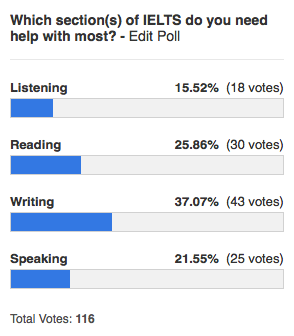 This article is part of the Teach IELTS series at IELTS Academic, which provides skills training for IELTS and English as a foreign language.
This article is part of the Teach IELTS series at IELTS Academic, which provides skills training for IELTS and English as a foreign language.
IELTS is one of the world’s leading tests of English, with more than 2.5 million tests taken in 2014. Yet there is no IELTS teaching licence, nor any recognised course in how to teach IELTS. Many teachers are simply thrust into their first IELTS teaching situation without much preparation, or it may come in the form of a request from a student. If that sounds like you, here are some useful steps that can bring you quickly up to professional speed.
1. Which IELTS test do your students intend to take?
There are two versions of the IELTS test: Academic and General Training. People take IELTS Academic to enter an English-speaking university or work overseas in a profession such as healthcare. They will need to build competence in appropriate academic uses of English, such as presenting a written or spoken argument. IELTS General Training is for immigration and citizenship purposes, and the reading and writing tasks are more focussed on everyday uses of English.
2. Make yourself familiar with the IELTS test structure
The IELTS test consists of four modules: Listening, Reading, Writing and Speaking. IELTS is a paper-based test, except for the Speaking module which is a face-to-face interview. No computers are involved. The test takes around three hours in total, and the Speaking part is often held on a separate day. These four articles provide a quick overview of what each section entails:
IELTS Academic Reading: Introduction
IELTS Academic Writing: Introduction
3. Have the students taken IELTS before?
If so, ask for their scores in advance. If not, ask them to sit a diagnostic test. Some textbooks include a full practice test. There’s also one on the British Council website.
 IELTS scores range from 0 to 9 and most students will be aiming for a score of 5 to 7. Universities often set requirements for each of the four sections, and students will often want to focus on one or two sections in particular. This poll conducted by IELTS Academic shows the kind of help students want most.
IELTS scores range from 0 to 9 and most students will be aiming for a score of 5 to 7. Universities often set requirements for each of the four sections, and students will often want to focus on one or two sections in particular. This poll conducted by IELTS Academic shows the kind of help students want most.
IELTS students can have totally different needs. Those with higher scores in Listening and Speaking may have spent some time in an English-speaking environment and now need familiarisation with Academic English. Conversely, those with higher scores in Reading and Writing may have spent years studying from books and now require communicative teaching methods.
4. Choose an IELTS textbook
At this stage, you’re likely to be considering which textbook to use. See our Top 5 IELTS Textbooks for Classroom Use for some ideas. The advantages of textbooks are obvious: they provide authentic test practice, remove much of the burden of lesson-planning, and give students something to do outside class. At the same time, you can also learn how to teach IELTS by leading your students through a well-designed course of study. Later, when you have more IELTS teaching experience, you’ll come to rely less on textbooks and do more ‘teaching to the test’.
5. Improvise practice opportunities
You don’t need an IELTS textbook to start helping students to prepare. You can begin by selecting materials or designing activities that correspond approximately to the tasks students will face in the test. Many of these are quite common tasks in EFL classrooms:
- Listen for information
- Read and comprehend lengthy magazine-type articles (IELTS Academic only)
- Read and comprehend simple written texts (IELTS General Training only)
- Write a short description of a diagram (IELTS Academic only)
- Write a short informal letter (IELTS General Training only)
- Write a short essay
- Answer personal questions in an interview
- Speak about a personal topic for 1-2 minutes
- State opinions on a variety of discussion topics
Take it further
These five steps are only intended to get you started, especially if thrust at short notice into an IELTS teaching situation. To learn how to teach IELTS effectively, try out the most popular textbooks on your students, but don’t come to rely on only one source. There isn’t a great deal of literature on teaching IELTS, but the Teach IELTS section of this website includes further teaching tips and resources.
IELTS is a fast-growing test around the world, spurred by growth in international student mobility. You should seriously consider adding IELTS to your repertoire if teaching English is going to be your occupation for the foreseeable future. For advice on the long-term prospects of becoming an IELTS teacher, see Teaching IELTS for a Living: The Complete Guide.
 This article is part of the Teach IELTS series at IELTS Academic, which provides skills training for IELTS and English as a foreign language.
This article is part of the Teach IELTS series at IELTS Academic, which provides skills training for IELTS and English as a foreign language.
